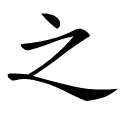之
- to go, proceed, advance;
(classical) third-person pronoun: “it / him / her / them”
(classical) particle: genitive marker “of,” subordinator, or nominalizing / linking word
Etymology
Originally pictographic, later serving as a semantic loan.
In early inscriptions, 之 appears as 㞢, showing the form of a foot (止) with an extra stroke, symbolizing motion or proceeding forward.
Some scholars interpret it as a derivative of 止 (“to stop / foot”), where the added line 一 indicates “to move.”
It may also have merged two originally distinct morphemes:
- to go (verb),
- third-person pronoun (it / that).
Thus, it functioned both as a verb meaning “to go” and as a grammatical marker or pronoun from early classical Chinese onward.
When used as a radical or component, 之 rarely appears in full. Instead, it transforms into derivatives of 㞢, such as ⺧, 土, or 士, depending on the structure of the compound.
Historical forms:
Oracle bone script (甲骨文): a stylized foot with a short stroke—suggesting motion.
Bronze script (金文): more linearized, used interchangeably with 㞢.
Seal script (小篆): standardized into a smooth form resembling the modern 之.
Words that derived from 之
Additional notes
Core functions in Classical Chinese:
1. Verb — “to go, to proceed”
之南之北。 — “He goes south and north — wandering aimlessly.”
孟子之平陸。 — “Mencius went to Pinglu.”
2. Third-person pronoun — “it / him / her / them”
學而時習之。 — “To study and constantly review it.” (Analects 1:1)
子貢問曰:「孔文子何以謂之文也。」
“Zigong asked: ‘Why was Kong Wenzi given the posthumous title Wen?’”
佰牛有疾, 子問之。自牖執其手, 曰:「亡之, 命矣夫!」
“When Bai Niu fell ill, Confucius went to see him, held his hand through the window, and said, ‘He is gone — such is fate.’”
3. Predicate marker — marks or repeats an action for rhythm
左之右之。 — “Turning left and right as he pleases.”
手之舞之,足之蹈之。 — “His hands dance, his feet stamp.” (Book of Rites, 乐记)
4. Proximal demonstrative — “this / such”
之二蟲又何知。 — “What do these two insects know?” (Zhuangzi 1)
之子于歸,宜其室家。 — “This maiden goes to her marriage — may her household be blessed.” (Book of Songs, 周南·桃夭)
5. Grammatical particle
Genitive / attributive (“of”)
漁夫之利 — “the fisherman’s gain”
黃巢之亂 — “the rebellion of Huang Chao”
十分之一 — “one tenth”
Adjectival linker (“~that is...”)
蚓無爪牙之利,筋骨之强。 — “The earthworm has neither sharp claws nor strong bones.”
Object–predicate inversion marker
何罪之有。 — “What crime is there?”
德之不修、學之不講、聞義不能徒、不善不能改,是吾憂也。
“Failing to cultivate virtue, to study, to follow righteousness, or to correct faults — these are my worries.” (Analects 7:3)
Clause-internal marker / subordinator
人性之善也,猶水之就下也。 — “Human nature’s goodness is like water’s tendency to flow downward.” (Mencius 6A)
說之,故言之;言之不足,故長言之;長言之不足,故嗟嘆之;嗟嘆之不足,故不知手之舞之足之蹈之也。
“He rejoices and thus speaks; when speech is insufficient, he extends it; when that is insufficient, he sighs; when sighing still fails, he knows not that his hands dance and his feet stamp.” (Book of Music, 樂記)
Linguistic and cultural notes:
In four-character idioms, 之 often appears in the third position: pattern A B 之 C. e.g. 物極之反 (“when things reach their extreme, they reverse”).
In Japanese, 之 corresponds to the particle の, carrying the same “of” relation.
In Korean, the character survives mainly in Classical quotations or fixed idioms.
In calligraphy and cursive scripts, the form of 之 was frequently simplified; the cursive forms eventually gave rise to the Japanese hiragana し and katakana シ.
Summary:
之 is among the most functionally diverse and historically important Chinese characters.
Originally a pictograph meaning “to go”, it later absorbed a pronominal and grammatical role, functioning as a marker of possession, relation, or subordination throughout Classical Chinese.
It embodies the evolution: lexical verb → pronoun → grammatical particle, illustrating how meaning in Chinese can shift from movement to connection, from physical action to syntactic glue — the path from “to go” to “of.”
Derived characters
Because 之 originated from 㞢 (a simplified foot form), it frequently appears transformed inside other characters:
⺧ — inside components (所, 阝 variants), contracted motion element.
土 — simplified bottom stroke (志, 士, 壬), early orthographic simplification.
士-like form — in characters of meaning “man / earth” (士, 壬, 正), graphic fossilization of 㞢’s lower stroke.
㞢 — original archaic form (found in bronze inscriptions), denotes “movement / direction.”
